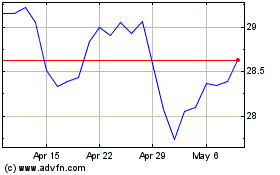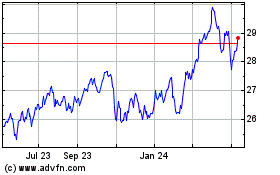CORRECT: US Gasoline Futures Off 16 Cents With Fall In 7 Of 8 Trading Days
April 24 2012 - 6:40PM
Dow Jones News
U.S. gasoline futures prices have dropped 16 cents a gallon,
with declines in seven of the past eight trading days, as more U.S.
crude becomes available for refining into gasoline and fears about
a shortage of refining capacity fades.
Helping to spur the downturn is the early reversal of a pipeline
that will allow refiners in the key Gulf Coast region greater
access to crude, the basic feedstock for gasoline. North Sea Brent
crude, the international benchmark crude which holds sway over
gasoline prices, already has fallen by more than $7 a barrel this
month, in part due to the increased competition.
Reformulated gasoline blendstock futures fell 2.8 cents Tuesday
to settle at $3.1593 a gallon and has repeatedly traded near
seven-week lows in recent days. Many traders said futures prices
may have hit their summer peak in late March, at near $3.42 a
gallon, and see prices falling further in coming weeks, easing
worries at the pump.
The decline in gasoline futures comes at a time when the U.S.
oil benchmark, West Texas Intermediate, has climbed 0.51% this
month. But gasoline, both domestically and internationally is
priced off Brent crude.
Friday, Brent crude lost $0.55 a barrel, or 0.46%, to settle at
$118.16 a barrel for June delivery on the InterContinental
Exchange. West Texas Intermediate settled $0.44, or 0.43%, higher
at $103.55 a barrel on the New York Mercantile Exchange.
The move by Enbridge Inc. (ENB) and Enterprise Products Partners
LP (EPD) to reverse the Seaway Pipeline in mid-May will free up
crude oil bottled up in landlocked storage at Cushing, Okla.,
keeping pressure on Brent prices, analysts said. The companies
accentuate the reveral's effect by moving up the date when it will
begin carrying crude from Oklahoma to the Gulf Coast -- on or
around May 17 from June 1.
Meanwhile, the market may not be suffering from a reduction of
refining capacity on the East Coast.
"Refinery operations may not be as much of a problem as
thought," said Kyle Cooper, managing partner at IAF Energy
Advisors. "Overall inventories are in good shape and certainly
demand has been lackluster."
The federal Energy Information Administration warned in late
February that the closure of several refineries in the Northeast
U.S. and offshore facilities that export to the region threatened
to significantly tighten supplies and could case price spikes.
But ConocoPhillips (COP) said it is talking with Delta Air Lines
(DAL) about restarting its Philadelphia area refinery that was shut
last year and Sunoco Inc. said it is in talks with Carylye Group, a
private equity firm, about the possibility of a joint venture to
keep open the 330,000-barrels-a-day Philadelphia refinery it
planned to shut this summer if it couldn't sell it.
East Coast refiners are highly reliant on crude oil that is
priced close to Brent, which had been inflated by the planned July
1 Europe Union embargo on Iranian crude oil imports. Analysts said
that after Iran agreed to further meetings with the permanent five
members of the United Nations Security Council and Germany on its
nuclear weapons program and Saudi Arabia boosted output, prices
have tumbled in recent weeks.
Jim Ritterbusch, president of Ritterbusch and Associates, said
that if U.S. oil inventories continue to grow, RBOB could drop to
$2.95 a gallon in two to three weeks.
If the market can avoid refining snags and a flare up of the
Iran tensions, prices may have peaked.
"We are always subject to supply disruptions and geopolitics,
but if we avoid that, it's quite possible we've seen the top," said
IAF's Cooper.
The national average retail price of regular gasoline fell 5.2
cents a gallon to $3.87 a gallon in the week ended Monday and
dropped below the year-ago level for the first time since Oct. 19,
2009, the Energy Information Administration said.
Michael McNamara, analyst at MasterCard's SpendingPulse
division, said gasoline prices would need to drop to around $3 to
$3.30 a gallon to spark a significant rise in demand from a year
ago. Year-to-date demand is off 5.5% from the comparable period in
2011, according to SpendingPulse data.
-By David Bird, Dow Jones Newswires; 212-416-2141;
david.bird@dowjones.com
Enterprise Products Part... (NYSE:EPD)
Historical Stock Chart
From Mar 2024 to Apr 2024

Enterprise Products Part... (NYSE:EPD)
Historical Stock Chart
From Apr 2023 to Apr 2024
